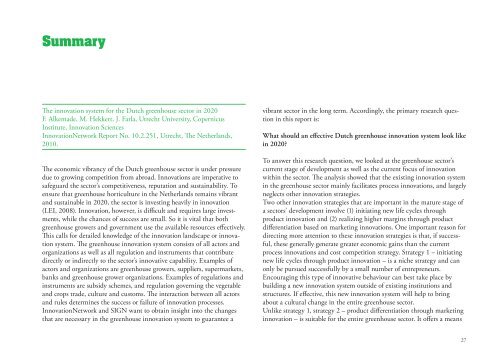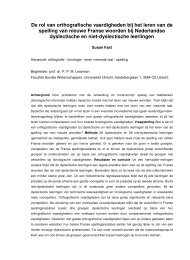Het innovatiesysteem voor de glastuinbouw in ... - InnovatieNetwerk
Het innovatiesysteem voor de glastuinbouw in ... - InnovatieNetwerk
Het innovatiesysteem voor de glastuinbouw in ... - InnovatieNetwerk
Create successful ePaper yourself
Turn your PDF publications into a flip-book with our unique Google optimized e-Paper software.
Summary<br />
The <strong>in</strong>novation system for the Dutch greenhouse sector <strong>in</strong> 2020<br />
F. Alkema<strong>de</strong>, M. Hekkert, J. Farla, Utrecht University, Copernicus<br />
Institute, Innovation Sciences<br />
InnovationNetwork Report No. 10.2.251, Utrecht, The Netherlands,<br />
2010.<br />
The economic vibrancy of the Dutch greenhouse sector is un<strong>de</strong>r pressure<br />
due to grow<strong>in</strong>g competition from abroad. Innovations are imperative to<br />
safeguard the sector’s competitiveness, reputation and susta<strong>in</strong>ability. To<br />
ensure that greenhouse horticulture <strong>in</strong> the Netherlands rema<strong>in</strong>s vibrant<br />
and susta<strong>in</strong>able <strong>in</strong> 2020, the sector is <strong>in</strong>vest<strong>in</strong>g heavily <strong>in</strong> <strong>in</strong>novation<br />
(LEI, 2008). Innovation, however, is difficult and requires large <strong>in</strong>vestments,<br />
while the chances of success are small. So it is vital that both<br />
greenhouse growers and government use the available resources effectively.<br />
This calls for <strong>de</strong>tailed knowledge of the <strong>in</strong>novation landscape or <strong>in</strong>novation<br />
system. The greenhouse <strong>in</strong>novation system consists of all actors and<br />
organizations as well as all regulation and <strong>in</strong>struments that contribute<br />
directly or <strong>in</strong>directly to the sector’s <strong>in</strong>novative capability. Examples of<br />
actors and organizations are greenhouse growers, suppliers, supermarkets,<br />
banks and greenhouse grower organizations. Examples of regulations and<br />
<strong>in</strong>struments are subsidy schemes, and regulation govern<strong>in</strong>g the vegetable<br />
and crops tra<strong>de</strong>, culture and customs. The <strong>in</strong>teraction between all actors<br />
and rules <strong>de</strong>term<strong>in</strong>es the success or failure of <strong>in</strong>novation processes.<br />
InnovationNetwork and SIGN want to obta<strong>in</strong> <strong>in</strong>sight <strong>in</strong>to the changes<br />
that are necessary <strong>in</strong> the greenhouse <strong>in</strong>novation system to guarantee a<br />
vibrant sector <strong>in</strong> the long term. Accord<strong>in</strong>gly, the primary research question<br />
<strong>in</strong> this report is:<br />
What should an effective Dutch greenhouse <strong>in</strong>novation system look like<br />
<strong>in</strong> 2020?<br />
To answer this research question, we looked at the greenhouse sector’s<br />
current stage of <strong>de</strong>velopment as well as the current focus of <strong>in</strong>novation<br />
with<strong>in</strong> the sector. The analysis showed that the exist<strong>in</strong>g <strong>in</strong>novation system<br />
<strong>in</strong> the greenhouse sector ma<strong>in</strong>ly facilitates process <strong>in</strong>novations, and largely<br />
neglects other <strong>in</strong>novation strategies.<br />
Two other <strong>in</strong>novation strategies that are important <strong>in</strong> the mature stage of<br />
a sectors’ <strong>de</strong>velopment <strong>in</strong>volve (1) <strong>in</strong>itiat<strong>in</strong>g new life cycles through<br />
product <strong>in</strong>novation and (2) realiz<strong>in</strong>g higher marg<strong>in</strong>s through product<br />
differentiation based on market<strong>in</strong>g <strong>in</strong>novations. One important reason for<br />
direct<strong>in</strong>g more attention to these <strong>in</strong>novation strategies is that, if successful,<br />
these generally generate greater economic ga<strong>in</strong>s than the current<br />
process <strong>in</strong>novations and cost competition strategy. Strategy 1 – <strong>in</strong>itiat<strong>in</strong>g<br />
new life cycles through product <strong>in</strong>novation – is a niche strategy and can<br />
only be pursued successfully by a small number of entrepreneurs.<br />
Encourag<strong>in</strong>g this type of <strong>in</strong>novative behaviour can best take place by<br />
build<strong>in</strong>g a new <strong>in</strong>novation system outsi<strong>de</strong> of exist<strong>in</strong>g <strong>in</strong>stitutions and<br />
structures. If effective, this new <strong>in</strong>novation system will help to br<strong>in</strong>g<br />
about a cultural change <strong>in</strong> the entire greenhouse sector.<br />
Unlike strategy 1, strategy 2 – product differentiation through market<strong>in</strong>g<br />
<strong>in</strong>novation – is suitable for the entire greenhouse sector. It offers a means<br />
27
















